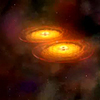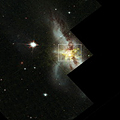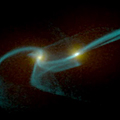CXC Home | Search | Help | Image Use Policy | Latest Images | Privacy | Accessibility | Glossary | Q&A

Black Hole Merger
Animation
QuickTime MPEG BROADCAST QUALITY
The movie shows a merger of two galaxies (simulation) that forms a single galaxy with two centrally located supermassive black holes surrounded by disks of hot gas. The black holes orbit each other for hundreds of millions of years before they merge to form a single supermassive black hole that sends out intense gravitational waves.
[Runtime: 0:43]
Animation: NASA/CXC/A. Hobart
Simulation: Josh Barnes (U. of Hawaii)/John Hibbard (NRAO)
Stills:
QuickTime MPEG BROADCAST QUALITY
The movie shows a merger of two galaxies (simulation) that forms a single galaxy with two centrally located supermassive black holes surrounded by disks of hot gas. The black holes orbit each other for hundreds of millions of years before they merge to form a single supermassive black hole that sends out intense gravitational waves.
[Runtime: 0:43]
Animation: NASA/CXC/A. Hobart
Simulation: Josh Barnes (U. of Hawaii)/John Hibbard (NRAO)
Stills:

Sequence of Hubble and Chandra
Images of NGC 6240
QuickTime MPEG
This sequence begins with a wide-field optical image of the galaxy NGC 6240 and then zooms into the central region where it dissolves to a Chandra X-ray image. The colors in the X-ray image show the intensity of the low (red), medium (green) and high (blue) energy X-rays. This image then dissolves to show only the highest-energy X-rays detected by Chandra, which come from gas around the two black holes in the center of the galaxy.
[Run time = 0:15 sec]
Credit: X-ray: NASA/CXC/MPE/S.Komossa et al.; Optical: NASA/STScI/R.P.van der Marel & J.Gerssen
QuickTime MPEG
This sequence begins with a wide-field optical image of the galaxy NGC 6240 and then zooms into the central region where it dissolves to a Chandra X-ray image. The colors in the X-ray image show the intensity of the low (red), medium (green) and high (blue) energy X-rays. This image then dissolves to show only the highest-energy X-rays detected by Chandra, which come from gas around the two black holes in the center of the galaxy.
[Run time = 0:15 sec]
Credit: X-ray: NASA/CXC/MPE/S.Komossa et al.; Optical: NASA/STScI/R.P.van der Marel & J.Gerssen

Galaxy Merger Simulation and Chandra
Data
QuickTime
MPEG
QuickTime
MPEG
- High Res (3 MB)
- Low Res (2.9 MB)
This sequence begins with a data simulation of two galaxies that are about to merge. The simulation then stops and fades into the highest-energy (5-8 keV) X-ray data of NGC 6240. These two distinct point sources in the Chandra data are proof to scientists that two black holes at the center of this galaxy.
[Runtime: 0:15]
Simulation: Josh Barnes (U. of Hawaii)/John Hibbard (NRAO); X-ray: NASA/CXC/MPE/S.Komossa et al.
Return to NGC 6240 (19 Nov 02)








